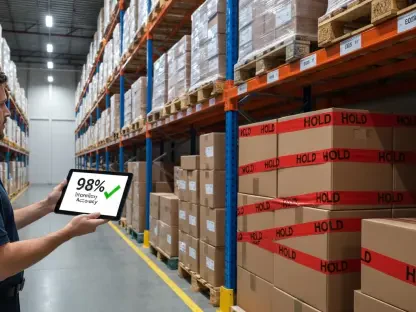Navigating a Crisis: Context and Importance of Air Cargo Stability
In the heart of a bustling global economy, air cargo serves as a critical lifeline, moving everything from life-saving medical supplies to cutting-edge electronics across continents in mere hours. As of early 2025, this vital sector faces an unprecedented challenge due to a federal government shutdown in the United States, sparked by a congressional stalemate over a spending plan. The US Airforwarders Association (AfA) has flagged this political gridlock as a severe threat to supply chain integrity, with millions of federal workers unpaid and key agencies hamstrung. This market analysis aims to dissect the immediate and long-term impacts of the shutdown on air cargo operations, spotlighting trends, risks, and strategic implications for stakeholders. Understanding these dynamics is essential, as disruptions in this sector could reverberate through commerce, affecting businesses and consumers alike with delayed goods and rising costs.
The significance of this issue extends beyond logistics into the broader economic landscape. Air cargo, often underappreciated, underpins just-in-time delivery systems that modern industries rely on for efficiency. With agencies like the Transportation Security Administration (TSA), Federal Aviation Administration (FAA), and US Customs and Border Protection (CBP) operating under strain, the potential for operational bottlenecks looms large. This analysis seeks to provide clarity on current market conditions while offering projections on how prolonged disruptions could reshape supply chain strategies. By delving into data and industry insights, the goal is to equip decision-makers with a roadmap to navigate this turbulent period.
Market Dynamics: Trends, Data, and Projections in Air Cargo
Immediate Disruptions: Staffing Shortages and Operational Slowdowns
The federal shutdown, which began in early 2025, has cast a shadow over air cargo operations, primarily through staffing shortages at critical federal agencies. TSA personnel, responsible for screening cargo, along with CBP staff handling import and export clearances, are working without pay, raising concerns about absenteeism. FAA employees, who manage air traffic control and route approvals, face similar challenges. Industry data suggests that absenteeism rates could mirror or exceed the 10% peak seen in past shutdowns, leading to significant delays at major hubs. These slowdowns threaten to create backlogs, pushing up costs for shippers and disrupting delivery schedules for time-sensitive goods.
Beyond the immediate bottlenecks, the market is witnessing a strain on capacity as cargo processing times lengthen. Smaller airports, with less staffing flexibility, are particularly vulnerable to these disruptions compared to larger hubs with more resources. The AfA has highlighted that such operational hiccups could deter businesses from relying on air cargo for urgent shipments, potentially shifting demand toward slower but currently more predictable alternatives like ocean freight. This trend, if sustained, risks eroding the competitive edge of air transport in speed-critical sectors like pharmaceuticals and technology.
Economic Ripple Effects: Supply Chain Vulnerabilities and Cost Implications
Analyzing broader market trends, the shutdown’s impact on supply chains reveals a fragile ecosystem already stressed by global trade uncertainties. Delays in cargo clearance and reduced FAA oversight on route certifications are creating a domino effect, with shippers facing higher expenses to reroute or reschedule shipments. Economic projections indicate that a prolonged shutdown could trim quarterly GDP growth by a measurable fraction, given air cargo’s role in facilitating high-value trade. Perishable goods and medical supplies, often transported by air, stand at particular risk of spoilage or delayed delivery, which could undermine consumer trust and market stability.
Sector-specific data points to heightened costs as a growing concern. Logistics firms may need to absorb additional expenses for temporary workarounds, such as hiring private security for cargo screening where federal support lags. While some market players argue that private sector innovation could mitigate federal shortfalls, the inconsistency and expense of such solutions limit their viability. The economic stakes are clear: without resolution, the shutdown could force a reevaluation of air cargo’s reliability, prompting long-term shifts in how industries allocate transportation budgets.
Future Outlook: Projections and Emerging Market Shifts
Looking ahead, market projections suggest that a sustained shutdown could accelerate structural changes within the air cargo sector. Industry leaders are exploring technological advancements, such as automated screening systems, to lessen dependence on federal staffing. However, these solutions require significant investment and time—potentially spanning from 2025 to 2027—to reach full implementation. In the interim, forecasts indicate a possible uptick in demand for alternative shipping methods, though these lack the immediacy that air cargo provides for critical goods, potentially reshaping market priorities.
Regulatory trends post-shutdown may also influence market dynamics. There is growing advocacy for contingency funding to ensure essential federal workers are paid during future crises, a measure supported by industry associations. Without such reforms, predictions warn of recurring disruptions that could erode confidence in air cargo as a dependable transport mode. Additionally, emergency federal interventions, like temporary waivers for cargo processes, might emerge as short-term fixes, though they carry risks of reduced oversight and safety concerns. The market’s trajectory hinges on whether political resolution prioritizes logistics stability in budget negotiations.
Reflecting on the Analysis: Strategic Insights and Forward-Looking Actions
Looking back on this market analysis, the federal shutdown of 2025 revealed critical vulnerabilities in the air cargo sector, with staffing shortages at TSA, FAA, and CBP driving operational delays and supply chain backlogs. The economic fallout underscored the sector’s pivotal role in national commerce, while projections highlighted potential long-term shifts toward alternative shipping methods and technological investments. These findings painted a picture of an industry at a crossroads, grappling with immediate challenges and the need for systemic resilience.
For businesses and logistics professionals, the path forward demands proactive strategies. Diversifying transport options by integrating ground or ocean freight for non-urgent goods offers a buffer against air cargo delays. Building inventory reserves for essential items helps mitigate risks of supply interruptions. Staying informed through industry alerts and advocating for congressional action through trade associations proves vital in pushing for resolution. These steps, while not exhaustive, provide a foundation for navigating the aftermath of the crisis and preparing for potential future disruptions in the air cargo market.









